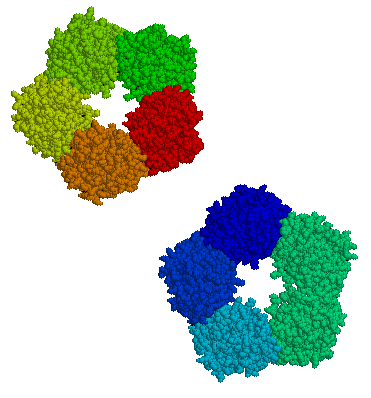Anti-inflammatory Celecoxib Improved Depression When Added to Escitalopram
Research has previously shown a link between stress, inflammation, and mood diorders. Anti-inflammatory treatments are now being explored for depression. In an abstract presented at the 2013 meeting of the Society of Biological Psychiatry, Nadia Alvi et al. reported that the commonly used anti-inflammatory COX-2 inhibitor celecoxib (Celebrex) showed better antidepressant effects than placebo when added to the selective serotonin reuptake inhibitor (SSRI) antidepressant escitalopram (Lexapro) in an 8-week study.
While this research has not yet been peer-reviewed, it can be found in the 2013 convention supplement (9S) to the journal Biological Psychiatry as abstract #661.
Editor’s Note: These data are consistent with an emerging literature that shows there are increases in signs of inflammation in both unipolar and bipolar depression. It remains to be determined whether those patients whose blood shows markers of inflammation (such as increases in C-reactive protein (CRP), interleukins 1 and 6, and TNF-alpha) are more likely to respond to anti-inflammatory treatment than patients in general.
Gap in Life Expectancy Between Psychiatric Patients and the General Population Grows
A study published by Lawrence et al. in the journal BMJ in 2013 suggests that the gap in life expectancy between psychiatric patients and the general population is widening. This was due more to poor physical health than to suicide.
Investigators at the University of Western Australia in Perth found that within that geographic region, the gap in life expectancy for males with all mental disorders combined compared to males in the general population increased from 13.5 years in 1985 to 15.9 years in 2005. For females, the gap increased from 10.4 years in 1985 to 12.0 years in 2005.
Editor’s Note: Data from the US suggest even greater loss of years of life expectancy in those with serious mental illnesses. In the best case, in Virginia patients lost an average of 13 years of life expectancy compared to the general population, while in some western states up to 28 years of life expectancy was lost by the average patient.
Cardiovascular disease is one of the biggest contributors to these almost unbelievable statistics. It is possible that short telomeres resulting from stressors, episodes of depression, abused substances, and a variety of poor lifestyle factors such as smoking and lack of exercise also contribute to this huge deficit in longevity. Other factors that can co-occur with bipolar illness, such as inflammation, high cortisol, and oxidative stress, are likely problematic as well.
Telomere Length Important for Health
 Elizabeth Blackburn (who won the Nobel Prize for medicine in 2009) gave a spectacular plenary lecture at the 2013 meeting of the American Psychiatric Association, in which she described the role of telomeres in psychiatric and other medical disorders. Telomeres are the strands of DNA at the end of each chromosome that protect the integrity of the DNA each time the cell replicates. The end is capped to prevent damage, degeneration, and genetic instability. A minimum length must be maintained for the protection of the cells.
Elizabeth Blackburn (who won the Nobel Prize for medicine in 2009) gave a spectacular plenary lecture at the 2013 meeting of the American Psychiatric Association, in which she described the role of telomeres in psychiatric and other medical disorders. Telomeres are the strands of DNA at the end of each chromosome that protect the integrity of the DNA each time the cell replicates. The end is capped to prevent damage, degeneration, and genetic instability. A minimum length must be maintained for the protection of the cells.
Telomeres shorten with aging and with each cell replication. They also shorten as a function of childhood adversity, stressors in adulthood, and number of episodes of depression. When a cell’s telomeres get too short, the cell enters a period of senescence, meaning it no longer replicates. Senescence is associated with a variety of adverse events, including the possibility of apoptosis (cell death), pro-inflammatory effects, and pro-tumor effects. The cell can begin to resemble a rotten apple that spreads its ill effects to others nearby. These effects can predispose a person to diseases such as diabetes, depression, attention deficit hyperactivity disorder (ADHD), anxiety disorders, pulmonary fibrosis, aplastic anemia, cardiovascular disorders (stroke and heart attack), osteoarthritis, immune abnormalities, dementia (in women), and premature aging.
Certain lifestyle alterations can increase telomere length, such as mindfulness/yoga training, exercise, sleep, omega-3 fatty acids, and having a positive purpose or meaning in life. Telomeres can also be lengthened by a synthetic enzyme called telomerase.
Other lifestyle factors can shorten telomeres or make telomerase less effective. Chronic stress can decrease the activity of telomerase by 50%. For people serving as the caregiver of a loved one, the longer the duration of this stress, the shorter the length of telomeres. High levels of what Blackburn described as cynical hostility also decrease telomere length.
Editor’s Note: Here we have more evidence that stress can affect our genes. We have written before about epigenetics, the study of the process by which environmental events such as stress can leave behind methyl and acetyl groups on DNA and histones that affect how easily DNA is turned on or off. Now it seems that stress can also have profound effects on the telomeres that cap each strand of DNA and keep it stable. An overly high proportion of short chromosomes is associated with a range of psychiatric and medical illnesses. This type of non-hereditary influence on genes could mediate some of the long-term effects of the environment on health. The good news for patients with bipolar disorder is that M. Schalling et al. found that treatment with lithium lengthened telomeres. Perhaps the bottom line of this whole collection of fascinating data is: Take good care of your telomeres, and they will take care of you.
The Myth of Neurogenesis in Adult Primates Debunked
In a plenary lecture at the Collegium Internationale Neuro-Psychopharmacologicum (CINP) in Istanbul in 2012, Pasco Rakic, professor of neuroanatomy at Yale University, may have debunked a myth of modern medicine, one that we have cited in many previous BNNs. Despite what has been written by famous neuroscientists and published in the most prestigious journals, including Science, Cell, and PNAS, based on data in rodents, Rakic presented evidence that neurogenesis does not occur to any substantial extent in adult primates.
Two decades ago, data in rodents and other species clearly indicated that neurogenesis, the creation of new neurons, occurred in adult animals, especially in the dentate gyrus of the hippocampus. Thousands of papers were written on the subject, and neurogenesis was understood to be possible in adult humans as well. It was even suggested based on data in rodents that the mechanism of action of antidepressants was dependent on neurogenesis. However, Rakic argues that most of the research on neurogenesis was based on faulty data.
Rakic found that while rats do have neurogenesis into adolescence, it diminishes greatly in older adult animals. In primates, neurogenesis in the cortex ends before birth. In the primate dentate gyrus of the hippocampus, there is some postnatal neurogenesis, but it rapidly drops toward zero in the first months of life. Rakic concludes: “We are as old as our neurons…or slightly younger.”
Why should primates have permanent stores of neurons when rodents and other lower animal species get new ones further into their lifespan? Rakic postulates that for primates, neurons must hold experience-dependent memories necessary for the survival of the species, and turning them over would endanger the permanence of this memory. Whatever the reason, it is disappointing to find out that the revolutionary discovery of adult neurogenesis in rodents so widely presumed to also occur in adult primates and humans may not be correct.
This has clinical implications. If we don’t get replacement hippocampal neurons like rats do, it is even more important to protect the billions of neurons that we do have. There are many things that endanger neurons, including inflammation, oxidative stress, high cortisol, poor diet, psychosocial adversity, and episodes of depression and mania. Greater numbers of mood episodes are associated with increasing degrees of cognitive dysfunction because of these many factors. A startling statistic from Denmark by Lars Kessing is that having four or more hospitalizations for depression (either unipolar or bipolar) doubles the risk for a diagnosis of dementia in late life. Thus, it looks like too many episodes hurt the brain.
However, on the positive side, the mood stabilizers (lithium, lamotrigine, valproate, and carbamazepine) and some atypical antipsychotics prevent episodes and increase the neuroprotective factor BDNF, or brain-derived neurotrophic factor, which facilitates synaptogenesis and helps protect neurons. BDNF is produced in selected neurons in the brain and decreases with stress and affective episodes, further endangering neurons. Since many effective treatments both prevent episodes and their associated decreases in BDNF and also directly increase BDNF, they may be having a dual positive benefit. The evidence is best for lithium having neuroprotective effects that can be directly observed in humans. Thus a not unreasonable mantra for patients with recurrent mood disorders is: “Prevent Episodes, Protect the Brain.”
Higher Levels of Caffeine in Blood May Be Associated With Lower Likelihood of Dementia
Alzheimer’s disease and other kinds of dementia can be devastating. Researchers are looking for treatments and lifestyle choices that may prevent, slow, or lessen the likelihood of serious dementia. Some epidemiological research in humans and other studies of animals has suggested that consumption of coffee or caffeine may help protect against the development of Alzheimer’s disease. A 2012 study by Arendash et al. published in the Journal of Alzheimer’s Disease sought to clarify the connection between coffee and cognitive status. The researchers also collected data on biomarkers in blood.
In patients with mild cognitive impairment, those patients whose blood levels of caffeine were 1200 ng/mL or higher (an amount that would result from drinking 3–5 cups of coffee daily) did not develop dementia during the following two to four years, while half of those whose blood levels of caffeine were below this threshold did. Moreover, those patients who had mild cognitive impairment at the beginning of the study had lower levels of caffeine than those who had normal cognitive functioning at that time.
Patients with mild cognitive impairment who later developed dementia had low levels of three biomarkers in their blood—the neurotrophic factor granulocyte colony-stimulating factor (G-CSF), the anti-inflammatory cytokine IL-10, and the pro-inflammatory cytokine IL-6. This suggests that low levels of these biomarkers may be an indicator of impending Alzheimer’s disease. G-CSF, in particular, has shown beneficial effects on cognition in mice.
Since half of patients with lower levels of caffeine did not develop dementia, it is clear that caffeine is far from being the only factor that could affect cognitive functioning. Arendash suggested that other factors may include levels of cognitive and physical activity, hypertension (high blood pressure), and antioxidant intake, especially from fruits and vegetables.
Editor’s Note: This study of caffeine was not randomized and is subject to other interpretations. For example, people who drink less coffee may have more hypertension, which is associated with dementia risk. However, the study does raise the possibility that caffeine could have positive effects on the brain (especially if it does not make a patient anxious or insomniac).
The caffeine findings are also supported by studies of dementia in mice. Long-term administration of caffeine to these animals resulted in a similar biomarker profile and prevented cognitive impairment.
Other treatments may also be useful in preventing cognitive decline. In BNN Volume 16, Issue 5 from 2012, we wrote about a one-year prospective study published by Forlenza et al. in the British Journal of Psychiatry in 2011 that showed that lithium at the small dose of 150mg per day reduced the rate of cognitive decline in those with mild cognitive impairment compared to placebo.
Immune Therapy Studied in Alzheimer’s Disease Fails
Following some research that inflammatory changes occur in patients with Alzheimer’s disease, immunotherapy with intravenous immunoglobin (IVIG), a treatment typically used to treat autoimmune diseases and neurological problems, was investigated in Alzheimer’s. The treatment consists of a mix of antibodies derived from the blood plasma of thousands of young, healthy blood donors, which are then delivered in a slow intravenous infusion. IVIG not only includes antibodies to particular proteins implicated in Alzheimer’s disease, but it also has general anti-inflammatory effects.
A particular dosage of IVIG (0.4g/kg every two weeks) seemed to completely stop progression of Alzheimer’s in the four patients who received it consistently for three years as part of a small open study. (Twenty other patients received other doses of IVIG or received placebo for part of the time, and the cognitive functioning of these patients deteriorated.) However, a large, double-blind, randomized study of IVIG did not show that the treatment had greater efficacy than placebo.
BDNF Is Decreased in Depression and Mania
Brain-derived neurotrophic factor (BDNF), which protects neurons and is necessary for long-term memory, can be measured in blood. In a symposium on bipolar disorder at the 2012 meeting of the Society of Biological Psychiatry, researcher Flavio Kapsczinski reviewed evidence from several meta-analyses showing that low levels of BDNF in the blood correlate with severity of an episode of depression or mania. In addition to the findings that BDNF levels are low during a mood episode, there are other reliable biomarkers of illness, including increases in intracellular calcium, increases in cortisol and failure to suppress cortisol by dexamethasone, and a variety of indices of inflammation and oxidative stress.
There are several common variants of the gene responsible for the production of BDNF, depending on which types of amino acids appear in its coding—valine or methionine. The Val66Val allele of proBDNF is the most frequently occurring in the population, and is the best-functioning variant. Those with a methionine substitution (Val66Met or Met66Met) have less efficient forms of BDNF. Researcher Jair Soares reported that the Met allele was associated with deficits in declarative memory in patients with bipolar disorder, and was also associated with smaller volume of the anterior cingulate gyrus.
Researcher Ghanshyam N. Pandey reported that patients with pediatric or adult bipolar disorder had decreased BDNF protein and mRNA levels in platelets and lymphocytes compared to controls. Treatment significantly increased these BDNF levels in the pediatric, but not in the adult bipolar subjects. These measurements in blood are consistent with findings that there are decreases in BDNF in the hippocampus and prefrontal cortex of patients who died while depressed or who committed suicide compared to controls.
CRP in Blood Predicts Onset of New Episode in Childhood Mood Disorders
At the 2013 meeting of the International Society for Bipolar Disorders, researcher Barbara Gracious presented evidence that increased levels of high sensitivity c-reactive protein (hsCRP), a marker of inflammation, were associated with an increased risk for developing a full-blown mood episode in 71 youth (average age 13.8) participating in a study called Longitudinal Assessment of Manic Symptoms (LAMS-2). The children were selected for the study because they had manic symptoms that were not severe enough to meet criteria for a diagnosis of bipolar I or II disorder. This research has not yet been published in a peer-reviewed journal, but the abstract can be found in first 2013 supplement of the journal Bipolar Disorders (page 67).
CRP levels are also known to predict cardiovascular disease and Type II diabetes.
Levels of 25-OH vitamin D, TNF?, and IL-6 did not predict a later mood disorder.
Editor’s Note: These data suggest the importance of assessing CRP and other markers in youth who are either prodromal (having early symptoms of a mood disorder) or at high risk because of a family history of a mood disorder.
The next step for clinical research would be to determine what treatment might decrease CRP and whether it would also prevent the development of mood episodes.
Inflammatory Markers May Predict Antidepressant Response
There appears to be a link between inflammation and depression. In the journal Neuropsychopharmacology, Cattanes et al. reported in 2013 that compared to controls, depressed patients had significantly higher baseline levels of inflammatory cytokines, less glucocorticoid receptor function, less neuroplasticity, and fewer neuroprotective factors. Certain variables predicted response to treatment, others were seen only in responders, and still others changed in everyone with antidepressant treatment.
Higher baseline levels of inflammatory markers interleukin IB, macrophage inhibitory factor (MIF), and tumor necrosis factor TNF? were each associated with nonresponse to antidepressant treatment, and the three combined accounted for 50% of the variance in response—that is, they were the major predictor of whether a patient responded to treatment.
Levels of other factors changed in only those patients who responded well to antidepressants. The biggest changes were the normalization in levels of the neurotrophic factors BDNF and VEGF.
Several other markers normalized with antidepressant treatment regardless of whether the patients responded to treatment, and these included decreases in cytokines interleukin-IB and MIF and improved glucocorticoid receptor function.
The three different kinds of findings about these biomarkers were observed regardless of what type of antidepressant was used—SSRI versus tricyclic nortriptyline (which blocks norepinephrine reuptake).
Editor’s Note: This study replicates other studies in depression where signs of inflammation have been observed, including increases in inflammatory cytokines, decreases in glucocorticoid receptor function (needed to suppress high levels of the stress hormone cortisol) and lower levels of neuroplasticity and neuroprotection markers. This, however, is one of the first studies to show that levels of these markers at baseline may predict response to antidepressant treatment.
Also novel are the findings that while some high interleukin levels at baseline predicted antidepressant non-response, other ones normalized only in responders, and still others changed with treatment independent of whether the patients’ depression improved. These exciting findings require replication, but suggest the future possibility of personalized medicine, that is, choosing medications based on an individual biochemical marker profile. Eventually direct use of anti-inflammatory agents may be necessary in those with the highest levels of cytokines (predicting non-response to conventional antidepressant treatment). The same types of studies are needed in bipolar depression to determine the relationship between these inflammatory markers and treatment response.
Proven Treatments for Fibromyalgia and Chronic Fatigue Syndrome
At the 2012 meeting of the Collegium Internationale Neuro-Psychopharmacologicum (CINP), a symposium was held to discuss fibromyalgia and chronic fatigue syndrome, two illnesses that remain mysterious.
Fibromyalgia
Fibromyalgia is more common in women than in men and is characterized by aching all over, decreased sleep, stiffness upon waking, and most prominently, being tired all day, as well as a host of other symptoms including headache, dizziness, and gastrointestinal upset. Researcher Siegried Kasper suggested that treating fibromyalgia requires more than just medication. His approach is known as MESS, which stands for medication, exercise, sleep management, and stress management.
Medications to treat the illness include milnacipran (not available in the US), duloxetine (Cymbalta, a serotonin-norepinephrine reuptake inhibitor or SNRI), or pregabalin (Lyrica), and if tolerated, low doses of the tricyclic amitriptyline (Elavil).
According to Kasper, SSRIs and anti-inflammatory drugs don’t work, and benzodiazepines decrease the deepest phase of sleep (stage 4) and can exacerbate the syndrome.
Recommended exercise is moderate, graded (to a pulse of about 120, or at a level where the patient can still talk, but can’t sing), and should be done in the early morning rather than the late afternoon where it might interfere with sleep.
Good sleep hygiene is recommended, such as keeping the same sleep schedule every day and abstaining from caffeine (even in the morning).
Working on developing active coping strategies for stressors that are likely to occur is a good idea. Mindfulness and other meditative techniques may also be helpful. Joining a support group (that encourages exercise rather than discouraging it) was also recommended.
Chronic Fatigue Syndrome
At the CINP meeting researcher Simon Wessely discussed chronic fatigue syndrome (CFS), which has many overlaps with fibromyalgia. He reported that careful controlled study of more than 15,000 individuals has not indicated that the illness is associated with a viral infection. Just as many people with and without chronic fatigue syndrome were found to be infected with a virus.
However, like the myth that vaccines cause autism, the myth that chronic fatigue is associated with a virus remains popular despite the lack of evidence. A large randomized study validated Wessely’s treatment techniques, but he has continued to be vilified for the position that the illness is not virally based. The study showed that patients who participated in cognitive behavior therapy and graded exercise improved more than those who received conventional medical management.
Wessely thought the most important cognitive change to make was accepting that exercise is not harmful for patients with chronic fatigue syndrome, and is in fact helpful and therapeutic. Many older treatment approaches had advocated rest, rest, and more rest, or even “intensive rest.” However, Wessely indicated that this would be counter-productive, as the patient would lose muscle mass and cardiovascular conditioning, and would become even more tired and chronically fatigued.










